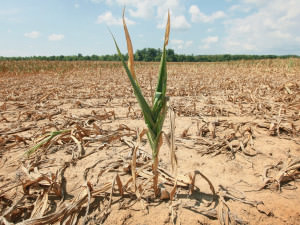The Effect of Rising Temperatures on Food Staples
Crops of food staples could be in danger around the world, leading to increased hunger in developing nations
By: Sarah Hartwick, Staff Writer
On coffee plantations around the world, the temperatures are already changing. The weather has become increasingly unpredictable; the heat of the tropical valleys is creeping up into the cool highlands. The delicate cycle of wet and dry seasons, essential for a healthy coffee tree, has been getting wetter and wetter.
The long, green coffee leaves are turning brown, “rusting,” as a fungus that has always died in the cool, dry weather survives to ruin plantation after plantation.
A study done in 2012 by the Royal Botanic Gardens in London, England warns that by 2080, Arabica coffee plants could be entirely extinct in the wild. We’d still be able to rely on domesticated varieties, but the study warns that prices would go up and quality would go down.
And your morning pick-me-up isn’t the only thing in danger.
As the world gets warmer, the foods we eat most often, including wheat, rice, and corn, will become more difficult to grow.
The International Food Policy Research Institute (IFDRI), an independent, U.S.-based think tank, conducted a study in 2010 in which showed that while climate change will affect different regions of the world in different ways, overall, “global cereal production will be between 3.2 and 8.2 per cent lower with climate change than in a perfect mitigation scenario, where all greenhouse gas emissions are halted and the inertia in the climate system is overcome.”
In an online analysis, of the report Food Security, Farming, and Climate change to 2050, IDFRI research fellow Nicholas Magnan writes that according to the report, wheat production worldwide could drop between five and ten per cent, maize or corn production between two and 10.5 per cent, and rice four per cent, depending on the climate scenario. An earlier study by the same institute found that in Sub-Saharan Africa and South Asia, rice production could drop by as much as 15 per cent.
While coffee farmers dread the increased rain, those growing wheat and corn are likely to suffer from hot, dry summers. Rice, often grown in low-lying regions like Vietnam’s the Mekong River delta, is more likely to succumb to flooding.
[pullquote]A study done in 2012 by the Royal Botanic Gardens in London, England warns that by 2080, Arabica coffee plants could be entirely extinct in the wild.[/pullquote]
Grains aren’t the only staple food to feel the heat; soy plantations are also vulnerable to rising temperatures. The World Wildlife Fund estimates that by the year 2070, the area of land suitable for soy production could drop by as much as 60 per cent if faced with drier, hotter summers. According to a 2009 research paper by Wolfram Schlenkera and Michael J. Roberts, soybean plants have a temperature threshold of about 30 degrees Celsius. After that point, the plants yield drops dramatically.
The U.S. government reports that soy is the second most-planted field crop in America, ranking just below corn, bringing in over $37 billion US for farmers annually.
In order to salvage as much agricultural land as possible, studies suggest that adapting growing seasons to suit a hotter climate, as well as taking measures to avoid eroding soil could be useful, as well as changing farming methods to be more conservative, saving as much water and energy as is possible.
One study, entitled Climate Change: Can Wheat Beat the Heat?, published in Agriculture, Ecosystems and Environment in 2008, puts forth the conclusion that in addition to changing farming practices around the world, it could also be beneficial for scientists to focus on breeding strains of wheat that could withstand high temperatures and drought conditions, ensuring income and food for people around the world.































Share the post "The Effect of Rising Temperatures on Food Staples"